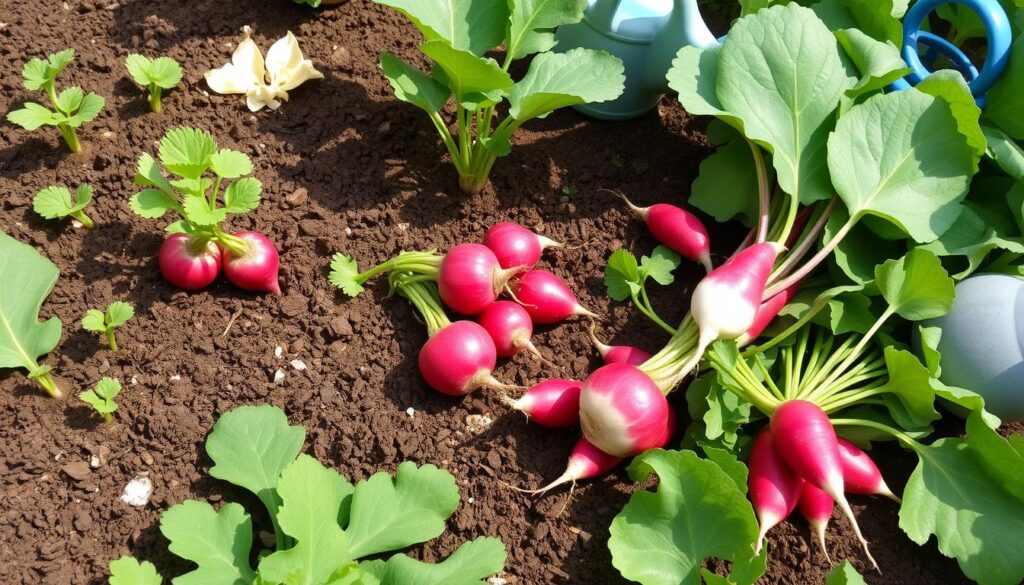Radishes are tasty and simple to grow. They can be ready in just 20 days. To start growing radishes, it’s key to learn the basics and use good planting tips.
With the right methods and patience, you can have a lot of fresh radishes. Our guide will teach you everything about growing radishes. This includes planting, caring, and harvesting tips for the best results.
Introduction to Radish Growing
Growing radishes is rewarding for both new and experienced gardeners. Our expert advice and proven tips will help you grow tasty radishes quickly. A reliable guide is essential for success.
Key Takeaways
- Radishes can be harvested in as little as 20 days
- Using a radish growing guide can help you get started with growing radishes
- Effective radish planting tips are essential for a successful harvest
- Our guide covers everything you need to know about growing radishes
- With the right techniques, you can enjoy a bountiful harvest of fresh, crunchy radishes
- A trusted radish growing guide can provide you with the best practices for planting, caring, and harvesting your radish crop
Benefits of Growing Your Own Radishes
Growing radishes from seed is rewarding. It adds fresh, nutritious food to your diet. Knowing the best conditions and care for radish plants leads to a good harvest. Radishes are packed with vitamins, minerals, and antioxidants.
Nutritional Value
Radishes are full of fiber, vitamin C, and potassium. They’re great in salads, sandwiches, and more. They also have antioxidants and compounds that fight chronic diseases.
Cost-Effective Gardening
Growing radishes saves money. By starting with seeds, you cut down on grocery costs. Plus, you get to enjoy the thrill of harvesting your own radishes.
Quick Harvest Satisfaction
Radishes grow fast, ready in 20 days or less. This quick growth gives you a sense of accomplishment and pride in your gardening skills.
With the right care and knowledge, growing radishes is a rewarding experience. It’s fun for both new and experienced gardeners. Enjoy the journey of growing your own radishes.
| Radish Variety | Days to Harvest | Nutritional Value |
|---|---|---|
| Cherry Belle | 20-25 | High in vitamin C and fiber |
| French Breakfast | 25-30 | Rich in potassium and antioxidants |
| White Icicle | 30-35 | Good source of vitamin K and manganese |
Understanding Different Radish Varieties
When growing radishes, knowing the different types is key. There are many radish varieties to pick from. Each has its own look and growing needs. Cherry Belle, White Icicle, and Black Spanish are some favorites.
Radishes vary in size, shape, color, and taste. Cherry Belle is small and sweet. White Icicle is long and spicy. Black Spanish is big and mild.
Choosing the right radish variety is important for a good harvest. Think about your garden’s climate, soil, and sunlight. The right radish varieties will make your garden flourish.
- Cherry Belle: small, round, sweet, and crunchy
- White Icicle: long, thin, spicy, and crunchy
- Black Spanish: large, black-skinned, mild, and sweet
Learning about the different types of radishes helps you grow a diverse garden. Your garden will be full of tasty and healthy radish varieties.
Best Growing Seasons for Radishes
Radishes are great for gardeners because they grow well in many seasons. Knowing when to plant radishes is key for a good harvest. They can be planted in spring or fall, and even indoors all year.
Spring Planting Timeline
In spring, plant radishes when the soil is ready. This is usually late March or early April. For indoor growing, start in late February or early March.
Fall Planting Schedule
In fall, plant radishes 8 weeks before the first frost. This lets them grow before winter. With the right tips, you can have a great fall harvest.
Year-round Indoor Options
For year-round radish growing, try indoor growing. With enough light and the right temperature, you can grow radishes anytime. This is perfect for those who want fresh radishes all year.
By following these tips, you can have a successful radish harvest. Whether in spring, fall, or indoors, radishes are a tasty and rewarding crop.
| Season | Planting Time | Harvest Time |
|---|---|---|
| Spring | Late March or early April | Late May or early June |
| Fall | 8 weeks before the first frost | Before the first frost |
| Indoor | Year-round | 20-25 days after planting |
How to Grow Radishes Successfully
To grow radishes, you need good soil, enough water, and the right radish care. First, pick a spot with well-draining soil and lots of sun or partial shade. Radishes do best in slightly acidic to neutral soil pH, making them perfect for many gardens. For tips on gardening in containers, check out container gardening guides and learn about the perks of growing radishes in pots.
Here are some important tips for growing radishes well:
- Water them often, but don’t overdo it
- Feed them regularly to help them grow strong
- Keep the soil moist but not too wet
By following these tips and giving your radishes the right care, you’ll get a big harvest. Make sure to weed and mulch your radish bed to keep it moist and weed-free.
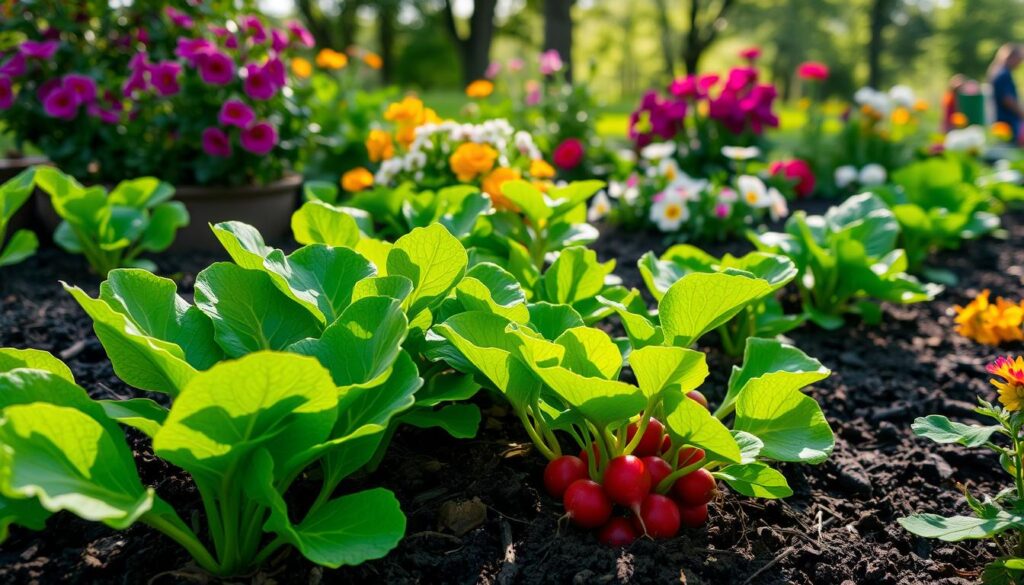
With the right radish care and attention, you can grow tasty and healthy radishes in your garden. Whether you’re new to gardening or have been doing it for years, growing radishes is a fantastic way to add flavor and nutrition to your food.
Selecting the Perfect Growing Location
Choosing the right spot is key for growing radishes. They need full sun to partial shade, meaning they should get direct sunlight for 4-6 hours a day. The soil should be well-draining and rich in organic matter. This helps prevent waterlogged soil and supports healthy root growth.
When planting radishes, space them 1-2 inches apart. This allows them to grow without competing for water and nutrients. Here are some important things to consider for the perfect growing location:
- Full sun to partial shade
- Well-draining soil rich in organic matter
- Good air circulation to prevent disease
- Adequate radish spacing for proper growth
Sunlight Requirements
Radishes need sunlight for photosynthesis and growth. Pick a spot that gets enough sunlight but also has some shade to avoid scorching.
Soil Conditions
The ideal soil for radishes is well-draining and rich in organic matter. Test your soil and amend it if needed to create the best growing environment.
Space Considerations
Radish spacing is important to prevent overcrowding and promote healthy growth. Plant them 1-2 inches apart. Also, leave enough space between rows for easy harvesting.
Essential Tools and Materials
To grow radishes, you’ll need some key tools and materials. You’ll need radish seeds, a garden bed or container, and radish fertilizers for healthy growth. A soil test kit is also helpful to check your soil’s pH and nutrient levels.
Other radish gardening tools like a garden rake, trowel, and watering can are useful. They help prepare the soil, plant seeds, and keep radishes watered and healthy.
When picking radish seeds, choose a variety that fits your climate and planting time. Using radish fertilizers can also help. With the right tools and materials, you’ll grow tasty and healthy radishes.
Here are some extra tips to remember:
- Use a garden bed or container that’s at least 6-8 inches deep for root growth.
- Plant radish seeds about 1-2 inches apart and 1/4 inch deep.
- Water your radishes regularly but avoid overwatering.
Soil Preparation Techniques
Before planting radishes, it’s key to prepare the soil right. Radishes need a pH between 6.0 and 7.0. Testing the soil is a must to check its pH and nutrient levels.
To get the soil ready, you’ll need to test the soil pH and tweak it if needed. You can buy a soil testing kit or send a sample to a lab. Based on the test, you might need to add stuff to make the soil better for growing.
Testing Soil pH
Testing soil pH is easy to do at home. You can buy a kit or try a DIY method to find your soil’s pH level.
Adding Amendments
After knowing your soil’s pH, you can add things to change it. You might need to add lime to make it higher or sulfur to make it lower. Adding compost or manure can also help make the soil better for growing.
Proper Drainage Setup
Good drainage is key for radish growth. You can make the soil drain better by adding organic matter or perlite. This stops the soil from getting too wet and makes sure radishes get the right moisture.
By using these soil prep methods, you can make a great place for your radishes to grow. Always test your soil and adjust as needed for the best results.
| Soil pH | Radish Growth |
|---|---|
| 6.0-7.0 | Optimal |
| Below 6.0 | Slow |
| Above 7.0 | Stunted |
Planting Radish Seeds Correctly
Planting radish seeds right is key to a good harvest. Planting radish seeds at the correct depth and spacing is essential. The best radish seed depth is about 1/4 inch. Seeds should be 1-2 inches apart in well-draining soil.
Soil should be moist but not too wet. This prevents seeds from rotting. Here are some tips for planting radish seeds:
- Choose a location with full sun to partial shade
- Use a soil with a pH between 6.5 and 7.0
- Water gently but thoroughly after planting
Proper radish seed spacing is also key. It prevents overcrowding, which can cause disease and pests. By following these tips, you’ll have a great harvest of radishes.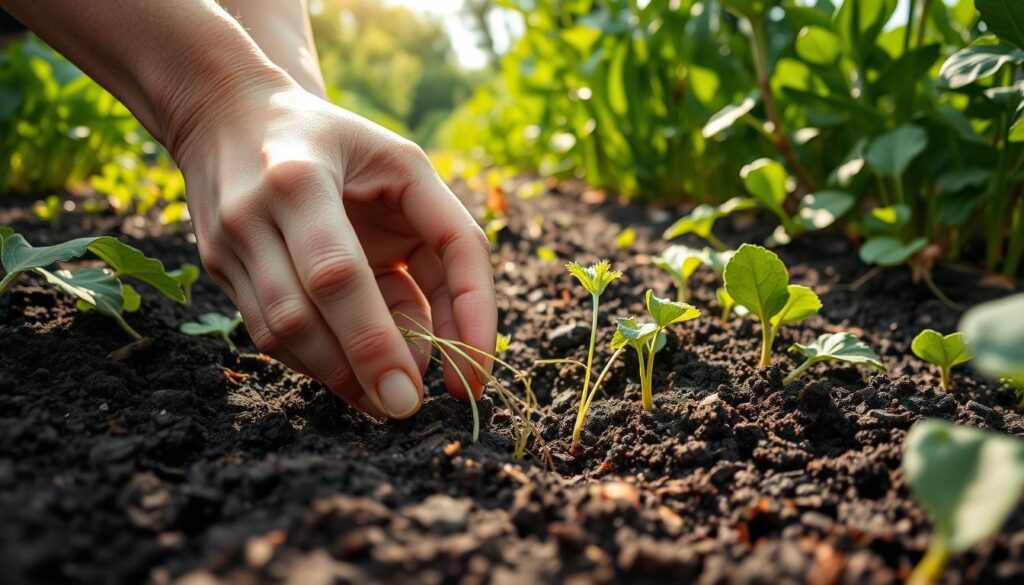
With the right techniques and patience, you’ll soon enjoy fresh radishes. Whether you’re new to gardening or experienced, planting radish seeds can add fun to your garden.
| Seed Depth | Seed Spacing | Soil Conditions |
|---|---|---|
| 1/4 inch | 1-2 inches | Well-draining soil with pH 6.5-7.0 |
Watering Requirements and Schedule
Watering radishes is key to their growth. They need consistent moisture to do well. But, too much water can cause root rot and other issues. Check the soil often to make sure it’s not too wet.
Watering radishes right means giving them enough moisture without drowning their roots. Radish moisture management is important here. Use drip irrigation or soaker hoses to water the roots directly. This cuts down on evaporation and runoff.
Initial Watering Guidelines
For new radish seeds, keep the soil moist for the first few weeks. This helps the seeds grow strong roots. As they grow, water them less often but don’t let the soil dry out.
Ongoing Moisture Management
To keep radishes moist, aim for 1-2 inches of water a week. This can be from rain or irrigation. Mulch helps keep the soil moist and cuts down on watering needs. By following these tips and watching how your radishes react, you’ll give them the right moisture to grow well.
- Water in the morning so plants can soak it up all day
- Don’t use overhead watering to avoid fungal diseases
- Use drip irrigation or soaker hoses to water roots directly
| Watering Method | Benefits |
|---|---|
| Drip Irrigation | Reduces evaporation and runoff, delivers water directly to the roots |
| Soaker Hose | Provides consistent moisture, reduces the need for frequent watering |
| Mulch | Helps retain moisture in the soil, reduces the need for frequent watering |
Container Growing Methods
Choosing the right container is key for growing radishes in containers. The container should be at least 6 inches deep for root growth. It’s also important to have good drainage holes to avoid waterlogging and root rot.
A well-draining potting mix and regular fertilization are vital for radish health. This ensures they grow well in their container home.
For successful radish care in containers, provide the right conditions. Place the container in a sunny spot and keep the soil moist but not soggy. Radish container gardening is fun and rewarding, giving you a fresh harvest in a small space.
Some tips for container-specific care include:
- Using a container with good drainage holes to prevent waterlogging
- Providing regular fertilization to promote healthy growth
- Keeping the soil consistently moist, but not waterlogged
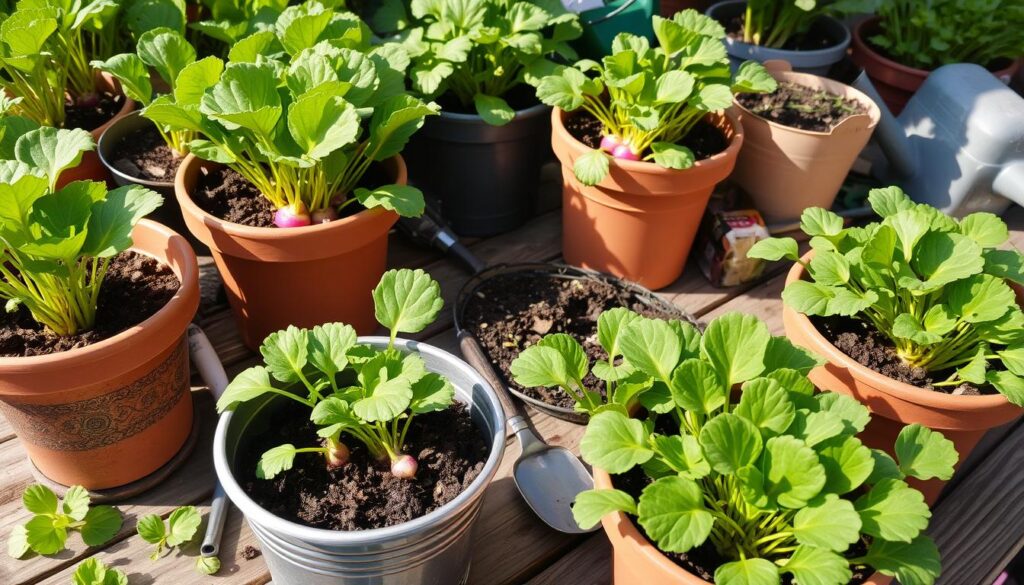
By following these tips and providing the right conditions, you can enjoy a successful radish container gardening experience. With proper care, you can grow delicious radishes in containers. They’re perfect for adding to salads, sandwiches, and more.
| Container Size | Drainage Holes | Potting Mix |
|---|---|---|
| At least 6 inches deep | Essential for preventing waterlogging | Well-draining mix for healthy growth |
Common Radish Growing Problems
Radish growers face many radish growing problems. These include pests, diseases, and not getting enough nutrients. Common pests are aphids, slugs, and snails. Diseases like powdery mildew and root rot also occur.
Some common radish pests and radish diseases include:
- Aphids: small, soft-bodied insects that feed on plant sap
- Slugs and snails: nocturnal pests that feed on leaves and roots
- Powdery mildew: a fungal disease that causes white, powdery growth on leaves
- Root rot: a fungal disease that causes roots to rot and decay
To avoid radish growing problems, keep your garden clean. Use organic pest control and ensure your soil is right. Check your plants often and act fast if you see any issues.
Knowing about these issues and how to stop them can help you grow radishes successfully. You’ll have a healthy harvest without radish pests and radish diseases.
| Problem | Cause | Solution |
|---|---|---|
| Aphids | Overwatering, poor air circulation | Use neem oil, introduce beneficial insects |
| Slugs and snails | Moist soil, lack of copper barriers | Use copper tape, hand-pick at night |
| Powdery mildew | High humidity, poor air circulation | Improve air circulation, use fungicides |
| Root rot | Overwatering, poor soil drainage | Improve soil drainage, reduce watering |
Natural Pest Control Methods
Managing pests in your radish crop is key. Natural pest control methods are a great way to do this. They protect your plants and keep the environment healthy. One good method is to bring in beneficial insects that eat common pests.
Aphids, flea beetles, and slugs can harm radish crops. To fight these pests, try organic pest control like row covers or neem oil. Also, keep your garden clean and remove weeds or debris to stop pests from coming.
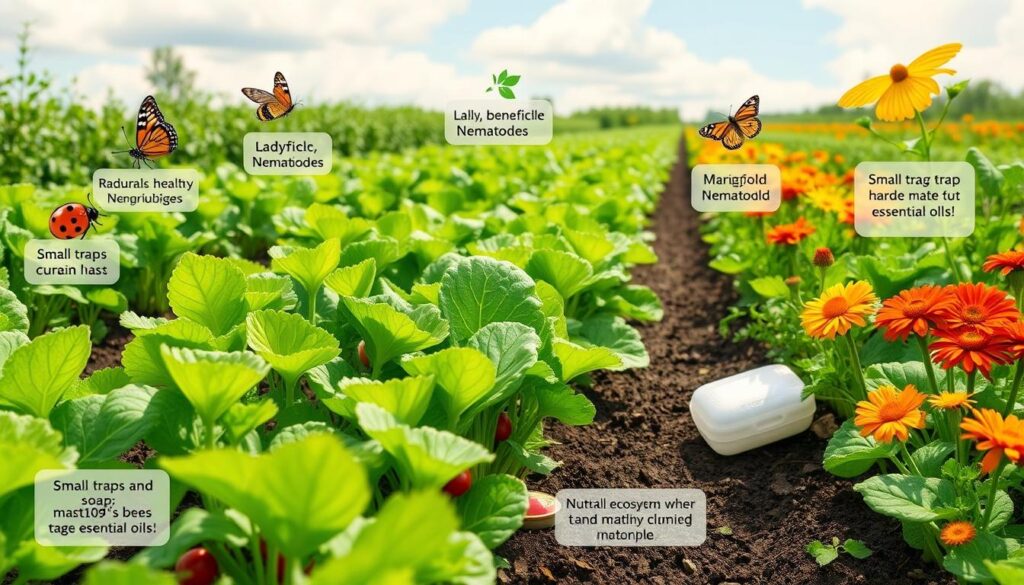
- Use companion planting to deter pests
- Keep your garden clean and free of debris
- Use organic pesticides as a last resort
By following these tips and using natural pest control, you can protect your radish crop. This helps create a healthy and balanced garden ecosystem.
Signs Your Radishes Are Ready to Harvest
Knowing when to harvest radishes is key to enjoying their best taste and texture. To see if your radishes are ready, look for certain signs and follow some timing tips. Most radishes are ready in 20-30 days after planting, depending on the type.
Visual Indicators
Here are the visual signs to check for:
- Size: Radishes are ready when they’re 1/2 to 1 inch in diameter.
- Color: The skin should be deep in color, and the flesh firm and crunchy.
- Shape: The radish should be evenly shaped, without cracks or splits.
Timing Guidelines
The exact time for harvesting radishes can change based on the variety, weather, and how you grow them. Generally, start checking for readiness about 20 days after planting. Use a fork to carefully dig around the plants, avoiding damage to the roots. If it’s ready, the radish should come out easily.
By using these tips, you can have a successful radish harvest. Enjoy the tasty flavor and crunchy texture of your homegrown radishes.
| Radish Variety | Days to Maturity | Harvest Time |
|---|---|---|
| Cherry Belle | 20-25 days | Early spring or late summer |
| French Breakfast | 25-30 days | Early spring or late summer |
| White Icicle | 30-35 days | Late spring or early summer |
Proper Harvesting Techniques
Harvesting radishes the right way is key to avoid damage. Use a fork to gently loosen the soil around the plants. Then, lift them out carefully to prevent bruising.
It’s important to handle radishes with care and harvest them at the right time. Here are some tips to keep in mind:
- Use a fork to loosen the soil, not a shovel or spade, to protect the roots.
- Lift the radishes out of the ground gently, without pulling or tugging on the roots.
- Be careful when handling radishes to avoid bruising or damaging them, which can affect their quality and storage life.
By following these tips and using proper techniques, you can have a great harvest. Storing radishes properly is also important to keep them fresh. With the right methods, you can enjoy your radishes for a longer time.
Storing and Preserving Your Radish Harvest
After you pick your radishes, it’s key to store them right. This keeps their taste and texture good. You can keep them in the fridge for about a week. For longer, try freezing, pickling, or dehydrating them.
To freeze radishes, blanch them first. This helps keep their texture and taste. You can also keep them cool and dry for longer freshness.
- Store radishes in a sealed container to maintain humidity and keep them fresh.
- Keep radishes away from direct sunlight and heat sources.
- Use radish freezing methods to preserve radishes for up to 8 months.
Follow these tips to enjoy your radish harvest longer. You can also try different ways to preserve radishes to meet your needs.
Conclusion
Growing radishes is a rewarding hobby for gardeners of all levels. This article has given you the tools to cultivate radishes successfully. You’ll enjoy a rich harvest from your radish gardening efforts.
Radishes are not just good for you; they’re also affordable and quick to grow. This makes them a great choice for gardeners looking for a fun and easy project.
With the right care, you can grow delicious radishes at home. Learn how to plant, water, and protect them from pests. This will help you enjoy the fruits of your labor.
As you get better at radish cultivation, try new varieties and recipes. Radishes are very versatile and can add flavor to many dishes.
Enjoy the journey of growing radishes and connect with nature. Celebrate your harvests and share your radishes with loved ones. Happy gardening!
FAQ
What are the benefits of growing your own radishes?
Growing radishes yourself offers many perks. You get fresh, healthy food, save money, and enjoy a quick harvest. Radishes are packed with vitamins, minerals, and antioxidants, making them great for your diet.
What are the different types of radish varieties?
There are many radish types, like Cherry Belle, White Icicle, and Black Spanish. Each has its own look and growing needs. Knowing these differences helps you pick the right radish for your garden and climate.
What are the best growing seasons for radishes?
Radishes grow well in spring and fall. In spring, plant them when the soil is ready. In fall, plant 8 weeks before the first frost. You can also grow them indoors all year, making them flexible for gardeners.
What are the essential tools and materials needed to grow radishes?
To grow radishes, you need a few key things. You’ll need radish seeds, a place to plant them, and fertilizer. A soil test kit can also help ensure your soil is perfect for radish growth.
How do you properly prepare the soil for growing radishes?
Preparing the soil for radishes is key. Test your soil pH to make sure it’s between 6.0 and 7.0. Add amendments as needed to improve the soil’s fertility and drainage. This will help your radishes grow strong and healthy.
How do you properly plant radish seeds?
Planting radish seeds right is important. Plant them 1/4 inch deep and 1-2 inches apart in well-draining soil. Make sure the soil is moist but not too wet, as this can cause the seeds to rot.
What are the watering requirements and schedule for growing radishes?
Radishes need consistent moisture but can be prone to overwatering. Water them regularly but avoid waterlogged soil. Using a drip irrigation system or soaker hose can help deliver water directly to the roots.
Can radishes be grown in containers?
Yes, radishes can grow well in containers. Choose a container that’s at least 6 inches deep with good drainage holes. Use a well-draining potting mix and fertilize regularly to promote healthy growth.
What are some common radish growing problems?
Radishes can face issues like pests, diseases, and nutrient deficiencies. Common problems include aphids, slugs, snails, powdery mildew, and root rot.
How can you use natural pest control methods to manage radish pests?
Natural pest control methods can help manage pests in your radish crop. Introduce beneficial insects, use physical barriers, and apply organic pesticides. Keeping your garden clean and removing weeds or debris that attract pests is also important.
How do you know when your radishes are ready to harvest?
Radishes are ready when they’re 1/2 to 1 inch in diameter, depending on the variety. Check for maturity by gently digging around the plants. Harvest them before they get too large and woody.
What are the proper techniques for harvesting radishes?
Harvesting radishes requires care to avoid damaging the roots or leaving any behind. Use a fork to gently loosen the soil, then lift the plants out. Handle the radishes gently to avoid bruising or damaging them.
How can you store and preserve your radish harvest?
Radishes can be stored in the fridge for up to a week. They can also be preserved by freezing, pickling, or dehydrating. Store them in a cool, dry place to keep their flavor and texture.
Share this post: on Twitter on Facebook

